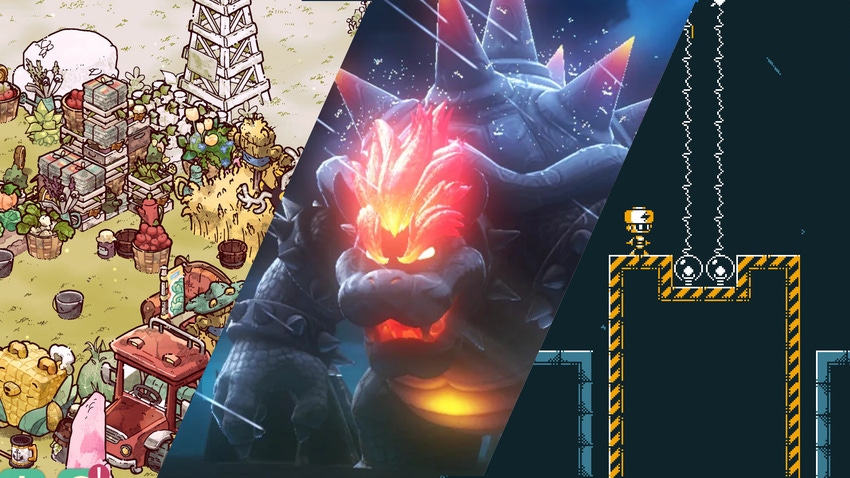Game Developer's Best of 2021: Holly Green's top 5 games
Game Developer's community editorial coordinator Holly Green shares the 5 games that made an impression on her during 2021.

2021 was a quiet year for me professionally. After being laid off at the start of COVID in 2020 and only writing a few articles per month until this past November, my interests in games had been limited by a strange and foreign new factor: my own personal interest. For once, the games I played in the calendar year were shaped not so much by the demands of the job, but by what I felt like playing.
A curious selection emerged from the carte blanche approach; as it turns out, my uncurated tastes aren’t necessarily broad. But they do speak to a time in my life where I just needed to play what I wanted to play, if and when I wanted to play it.
And I guess that makes this one of the most honest end-of-year lists I’ve curated in my entire career. I can think of no better way than to begin my career at Game Developer as we head into the new year.

Before this past March, if you’d asked me if the point and click horror genre had anything left to give, I’d have emphatically said no. But early in the year, we were graced with Mundaun, a title that breathed some new life into a set of staling conventions with its unique art direction and a story set in the Swiss Alps.
Admittedly, Mundaun won a lot of points with me by simply not being American. Horror, after all, is often strengthened by the unknown and unexpected, and there was nothing I could predict about the course of Mundaun. The tale centers on a young man who is lured back to his ancestral country home to attend to an ailing grandfather, only to be trapped in a deal with the devil gone wrong. From there, the game delves into a comment on the ominous underpinnings of the pastoral countryside, evoking themes of superstition, outsiderness, and rural alienation.
While structurally conventional (point and click puzzle fans are unlikely to find its formula challenging), Mundaun’s hand-drawn black and white illustrations and basis in Swiss folklore are a powerful combination. The illustrations are dark and rough in a way that feels as hostile as the game’s unsettling material. This was deliberate on the part of developer and artist Michel Ziegler, who cites the work of Dutch landscape painter Pieter Bruegel as inspiration for the game’s visual style, which is designed to mirror the eeriness of the countryside by turning the ordinary into the mysterious and oppressive. The result is devastatingly effective, making Mundaun anything but a mundane point-and-click horror game.
New Pokémon Snap, BANDAI NAMCO Studios

This year saw the much-demanded revival of the N64 classic Pokémon Snap, a game from Nintendo’s vast back catalog that always seemed among the best-suited to make the leap to high definition over the years. The wait was long but worth it. While New Pokémon Snap plays more like a wilderness safari than a freeform photographic journey, it packs in a lot of surprises and spontaneity for such an on-rails experience.
It’s those moments you don’t see coming that make New Pokémon Snap truly shine. Throughout 24 levels, multiple lush interactive environments act as the home slash staging area for Pokémon specific to their ecosystem, with special sightings and encounters only available under certain circumstances. While some of the rarest Pokémon can only be seen by performing elaborate sequences, using tools to draw out specimens and encourage unique behavior, the pay-off is so satisfying--especially when that pay-off includes seeing a Pokémon in one of its most beautiful rendered forms.
New Pokémon Snap won’t teach you anything new about photography--except maybe how to hone your quick thinking reflexes and stay on your toes. But the wonderful thing about its gameplay is that it encapsulates the same thrill of discovery as catching Pokémon without all the math and strategy of the regular series. If you simply want to enjoy the fantasy biology of the games and want to enjoy Pokémon for the beautiful creatures they are, New Pokémon Snap is the way to go.

At a glance, Cozy Grove was not a title I expected to like. Most of the hype for the game when it was released early this year drew comparisons to Animal Crossing, a series that I’ve never really been interested in. But Cozy Grove, starring a young Spirit Scout trapped on an abandoned island full of ghost-bears, hits all the right notes for a crafting and collection sim, with a premise that is the perfect cover. After all, who could be more interested in fishing, gathering seashells, collecting plant specimens, and making furniture than a cheery forest scout pursuing merit badges? As someone who loves both crafting and in-game collectibles, having such a sensible excuse for it is music to my ears.
The Girl Scout cosplaying isn’t the only part of Cozy Grove that I find comforting; as your scout helps out the spirits of the island, its black and white landscape comes back to life in a vibrant watercolor palette that reminds me of a children’s storybook, and the missions, primarily of the found object variety, bear serious Where’s Waldo? vibes. My only complaint? The gated progression barriers--there are only so many tasks you can complete per day, limiting the pace at which you can consume the game. While this was disappointing when I tried to binge the game in one go, it’s also a good thing that it just gave me more Cozy Grove to enjoy.
Elechead, Namatakahashi and Tsuyomi

They say imitation is the sincerest form of flattery from the mediocre. But while Elechead’s sources of inspiration are obvious, the game is anything but mediocre. The platformer, visually influenced by the Mega Man series, has a simple puzzle premise with staggeringly complex implications: whenever the titular character is touching a surface, that surface becomes electrified, triggering mechanisms that can hinder or help their way forward.
Adding dimension to this is the little hero robot’s tendency to lose his head. Elechead can remove his electrified noggin to act as a weight or trigger, helping him solve puzzles by eliminating obstacles or forming new bridges or open paths. In practice (at the risk of sounding a little…”getting a lot of Boss Baby vibes from this”), the platforming aspects feel not just like Mega Man but to me also a little like the Metropolis Zone from Sonic the Hedgehog 2, with a heavy industrial feel.
Released this past October by developer Namatakahashi, Elechead is a strong example of effective and simple visual design--the game’s menu is delivered solely in pictograph, and there is little to no in-game text outside the title screen. And as easy as it is to pick up, the platforming puzzles are dense enough that even a 20-minute session feels like heavy lifting. In a sense, Elechead proves that the best games are like good cooking: minimal, high-quality ingredients prepared well will always win out over budget and novelty.

As a companion game to Super Mario 3D World, the Nintendo Switch re-release of 2013’s Wii U original, Bowser’s Fury was a bit of a surprise. While it’s not uncommon for Nintendo to put out an older game on a new generation console, the bonus game was just icing on the cake. Not only did the new material better justify reissuing the old, but its sunny beach setting also revisited some of the better environments in the Mario series, harkening to bright favorites like Super Mario Galaxy’s Heavenly Beach Planet or Super Mario Odyssey’s Seaside Kingdom.
It’s a game so adorable that for a moment, you almost kind of forget its horrifying premise, that of a terrified child invoking the help of his sworn enemy to survive the landscape-shifting power of his father’s temper tantrums. A big part of the fun is actually in seeing the beach transformed by Bowser’s titular fury, and using the ensuing firestorm to your advantage. Sure, it’s scary when your dad gets mad, but how often does it also burn up blockages and disintegrate obstacles in your path or open up new level challenges in the sky?
While as a shorter standalone game, Bowser’s Fury doesn’t offer a full-length Mario game experience, it captures the best of its predecessors. Personally, I would love to see similar mini-adventures in the future, especially as a supplement to high-definition re-releases.
About the Author(s)
You May Also Like







